In-Depth Analysis of IPv4/IPv6 Addressing, Subnetting, and Routing
VerifiedAdded on 2023/04/23
|7
|1423
|392
Homework Assignment
AI Summary
This assignment provides a detailed overview of IPv4 and IPv6 addressing, subnetting, and routing protocols. It covers topics such as classful vs. classless addressing, subnet masks, NAT, ICMP, ARP, RIP, OSPF, and BGP. The assignment explains the differences between connection-oriented and connectionless services, fragmentation, and transition strategies from IPv4 to IPv6, including tunneling and dual-stack approaches. It also discusses address mapping protocols and the functions of RIP messages, comparing distance vector and link-state routing methods. Desklib offers a wealth of similar solved assignments and study resources for students.

NETWORKING
Paraphrase This Document
Need a fresh take? Get an instant paraphrase of this document with our AI Paraphraser
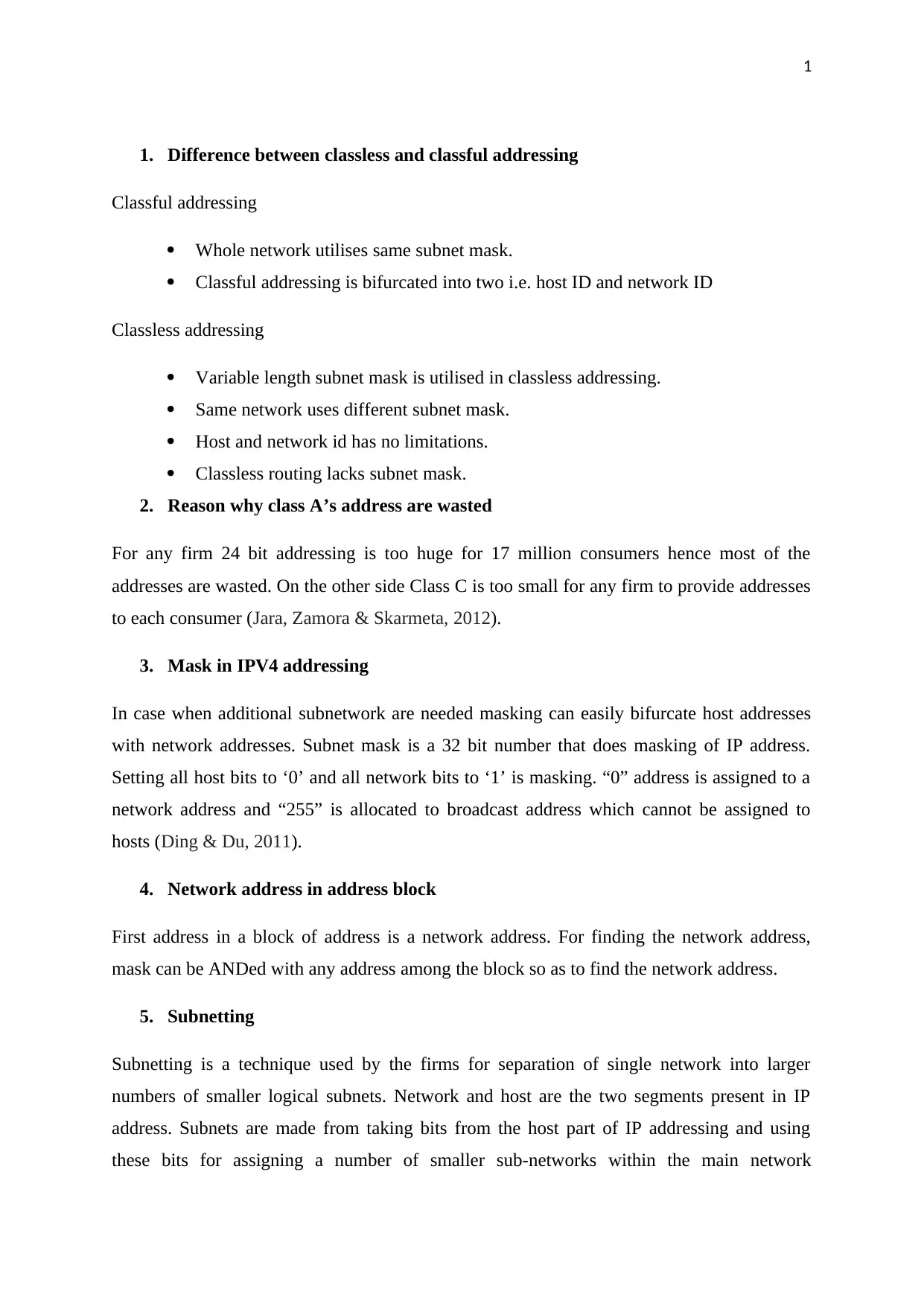
1
1. Difference between classless and classful addressing
Classful addressing
Whole network utilises same subnet mask.
Classful addressing is bifurcated into two i.e. host ID and network ID
Classless addressing
Variable length subnet mask is utilised in classless addressing.
Same network uses different subnet mask.
Host and network id has no limitations.
Classless routing lacks subnet mask.
2. Reason why class A’s address are wasted
For any firm 24 bit addressing is too huge for 17 million consumers hence most of the
addresses are wasted. On the other side Class C is too small for any firm to provide addresses
to each consumer (Jara, Zamora & Skarmeta, 2012).
3. Mask in IPV4 addressing
In case when additional subnetwork are needed masking can easily bifurcate host addresses
with network addresses. Subnet mask is a 32 bit number that does masking of IP address.
Setting all host bits to ‘0’ and all network bits to ‘1’ is masking. “0” address is assigned to a
network address and “255” is allocated to broadcast address which cannot be assigned to
hosts (Ding & Du, 2011).
4. Network address in address block
First address in a block of address is a network address. For finding the network address,
mask can be ANDed with any address among the block so as to find the network address.
5. Subnetting
Subnetting is a technique used by the firms for separation of single network into larger
numbers of smaller logical subnets. Network and host are the two segments present in IP
address. Subnets are made from taking bits from the host part of IP addressing and using
these bits for assigning a number of smaller sub-networks within the main network
1. Difference between classless and classful addressing
Classful addressing
Whole network utilises same subnet mask.
Classful addressing is bifurcated into two i.e. host ID and network ID
Classless addressing
Variable length subnet mask is utilised in classless addressing.
Same network uses different subnet mask.
Host and network id has no limitations.
Classless routing lacks subnet mask.
2. Reason why class A’s address are wasted
For any firm 24 bit addressing is too huge for 17 million consumers hence most of the
addresses are wasted. On the other side Class C is too small for any firm to provide addresses
to each consumer (Jara, Zamora & Skarmeta, 2012).
3. Mask in IPV4 addressing
In case when additional subnetwork are needed masking can easily bifurcate host addresses
with network addresses. Subnet mask is a 32 bit number that does masking of IP address.
Setting all host bits to ‘0’ and all network bits to ‘1’ is masking. “0” address is assigned to a
network address and “255” is allocated to broadcast address which cannot be assigned to
hosts (Ding & Du, 2011).
4. Network address in address block
First address in a block of address is a network address. For finding the network address,
mask can be ANDed with any address among the block so as to find the network address.
5. Subnetting
Subnetting is a technique used by the firms for separation of single network into larger
numbers of smaller logical subnets. Network and host are the two segments present in IP
address. Subnets are made from taking bits from the host part of IP addressing and using
these bits for assigning a number of smaller sub-networks within the main network
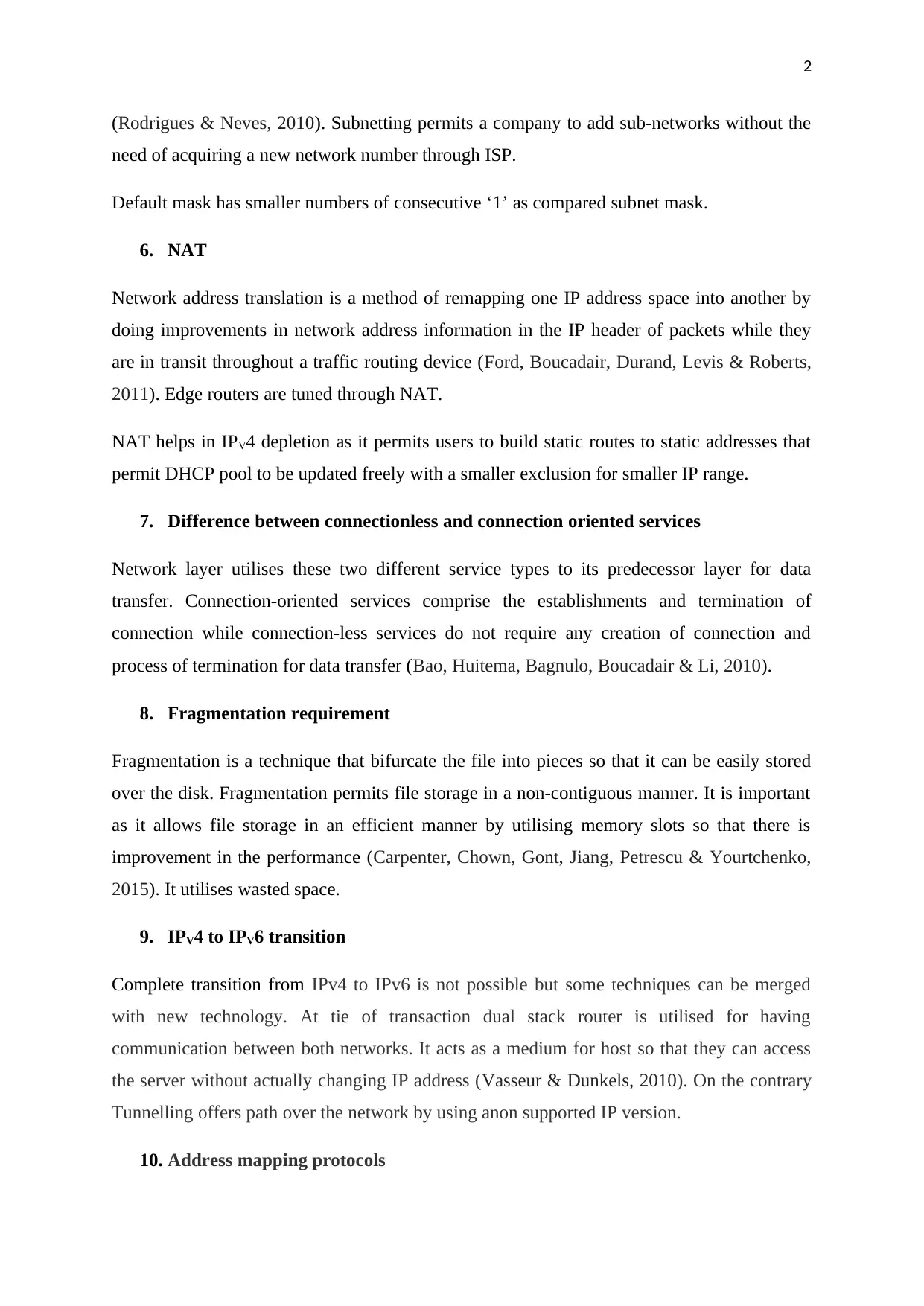
2
(Rodrigues & Neves, 2010). Subnetting permits a company to add sub-networks without the
need of acquiring a new network number through ISP.
Default mask has smaller numbers of consecutive ‘1’ as compared subnet mask.
6. NAT
Network address translation is a method of remapping one IP address space into another by
doing improvements in network address information in the IP header of packets while they
are in transit throughout a traffic routing device (Ford, Boucadair, Durand, Levis & Roberts,
2011). Edge routers are tuned through NAT.
NAT helps in IPV4 depletion as it permits users to build static routes to static addresses that
permit DHCP pool to be updated freely with a smaller exclusion for smaller IP range.
7. Difference between connectionless and connection oriented services
Network layer utilises these two different service types to its predecessor layer for data
transfer. Connection-oriented services comprise the establishments and termination of
connection while connection-less services do not require any creation of connection and
process of termination for data transfer (Bao, Huitema, Bagnulo, Boucadair & Li, 2010).
8. Fragmentation requirement
Fragmentation is a technique that bifurcate the file into pieces so that it can be easily stored
over the disk. Fragmentation permits file storage in a non-contiguous manner. It is important
as it allows file storage in an efficient manner by utilising memory slots so that there is
improvement in the performance (Carpenter, Chown, Gont, Jiang, Petrescu & Yourtchenko,
2015). It utilises wasted space.
9. IPV4 to IPV6 transition
Complete transition from IPv4 to IPv6 is not possible but some techniques can be merged
with new technology. At tie of transaction dual stack router is utilised for having
communication between both networks. It acts as a medium for host so that they can access
the server without actually changing IP address (Vasseur & Dunkels, 2010). On the contrary
Tunnelling offers path over the network by using anon supported IP version.
10. Address mapping protocols
(Rodrigues & Neves, 2010). Subnetting permits a company to add sub-networks without the
need of acquiring a new network number through ISP.
Default mask has smaller numbers of consecutive ‘1’ as compared subnet mask.
6. NAT
Network address translation is a method of remapping one IP address space into another by
doing improvements in network address information in the IP header of packets while they
are in transit throughout a traffic routing device (Ford, Boucadair, Durand, Levis & Roberts,
2011). Edge routers are tuned through NAT.
NAT helps in IPV4 depletion as it permits users to build static routes to static addresses that
permit DHCP pool to be updated freely with a smaller exclusion for smaller IP range.
7. Difference between connectionless and connection oriented services
Network layer utilises these two different service types to its predecessor layer for data
transfer. Connection-oriented services comprise the establishments and termination of
connection while connection-less services do not require any creation of connection and
process of termination for data transfer (Bao, Huitema, Bagnulo, Boucadair & Li, 2010).
8. Fragmentation requirement
Fragmentation is a technique that bifurcate the file into pieces so that it can be easily stored
over the disk. Fragmentation permits file storage in a non-contiguous manner. It is important
as it allows file storage in an efficient manner by utilising memory slots so that there is
improvement in the performance (Carpenter, Chown, Gont, Jiang, Petrescu & Yourtchenko,
2015). It utilises wasted space.
9. IPV4 to IPV6 transition
Complete transition from IPv4 to IPv6 is not possible but some techniques can be merged
with new technology. At tie of transaction dual stack router is utilised for having
communication between both networks. It acts as a medium for host so that they can access
the server without actually changing IP address (Vasseur & Dunkels, 2010). On the contrary
Tunnelling offers path over the network by using anon supported IP version.
10. Address mapping protocols
⊘ This is a preview!⊘
Do you want full access?
Subscribe today to unlock all pages.

Trusted by 1+ million students worldwide
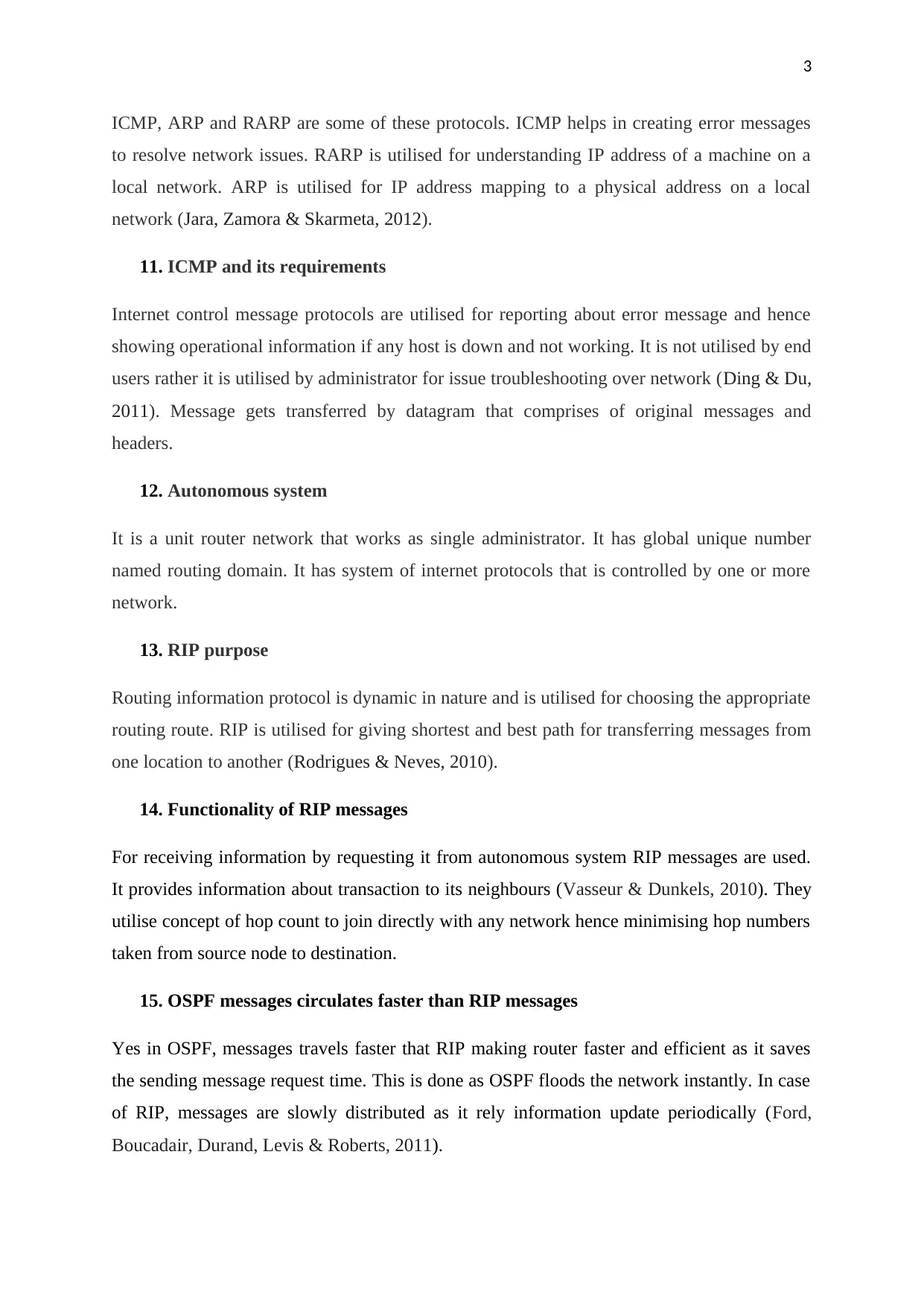
3
ICMP, ARP and RARP are some of these protocols. ICMP helps in creating error messages
to resolve network issues. RARP is utilised for understanding IP address of a machine on a
local network. ARP is utilised for IP address mapping to a physical address on a local
network (Jara, Zamora & Skarmeta, 2012).
11. ICMP and its requirements
Internet control message protocols are utilised for reporting about error message and hence
showing operational information if any host is down and not working. It is not utilised by end
users rather it is utilised by administrator for issue troubleshooting over network (Ding & Du,
2011). Message gets transferred by datagram that comprises of original messages and
headers.
12. Autonomous system
It is a unit router network that works as single administrator. It has global unique number
named routing domain. It has system of internet protocols that is controlled by one or more
network.
13. RIP purpose
Routing information protocol is dynamic in nature and is utilised for choosing the appropriate
routing route. RIP is utilised for giving shortest and best path for transferring messages from
one location to another (Rodrigues & Neves, 2010).
14. Functionality of RIP messages
For receiving information by requesting it from autonomous system RIP messages are used.
It provides information about transaction to its neighbours (Vasseur & Dunkels, 2010). They
utilise concept of hop count to join directly with any network hence minimising hop numbers
taken from source node to destination.
15. OSPF messages circulates faster than RIP messages
Yes in OSPF, messages travels faster that RIP making router faster and efficient as it saves
the sending message request time. This is done as OSPF floods the network instantly. In case
of RIP, messages are slowly distributed as it rely information update periodically (Ford,
Boucadair, Durand, Levis & Roberts, 2011).
ICMP, ARP and RARP are some of these protocols. ICMP helps in creating error messages
to resolve network issues. RARP is utilised for understanding IP address of a machine on a
local network. ARP is utilised for IP address mapping to a physical address on a local
network (Jara, Zamora & Skarmeta, 2012).
11. ICMP and its requirements
Internet control message protocols are utilised for reporting about error message and hence
showing operational information if any host is down and not working. It is not utilised by end
users rather it is utilised by administrator for issue troubleshooting over network (Ding & Du,
2011). Message gets transferred by datagram that comprises of original messages and
headers.
12. Autonomous system
It is a unit router network that works as single administrator. It has global unique number
named routing domain. It has system of internet protocols that is controlled by one or more
network.
13. RIP purpose
Routing information protocol is dynamic in nature and is utilised for choosing the appropriate
routing route. RIP is utilised for giving shortest and best path for transferring messages from
one location to another (Rodrigues & Neves, 2010).
14. Functionality of RIP messages
For receiving information by requesting it from autonomous system RIP messages are used.
It provides information about transaction to its neighbours (Vasseur & Dunkels, 2010). They
utilise concept of hop count to join directly with any network hence minimising hop numbers
taken from source node to destination.
15. OSPF messages circulates faster than RIP messages
Yes in OSPF, messages travels faster that RIP making router faster and efficient as it saves
the sending message request time. This is done as OSPF floods the network instantly. In case
of RIP, messages are slowly distributed as it rely information update periodically (Ford,
Boucadair, Durand, Levis & Roberts, 2011).
Paraphrase This Document
Need a fresh take? Get an instant paraphrase of this document with our AI Paraphraser
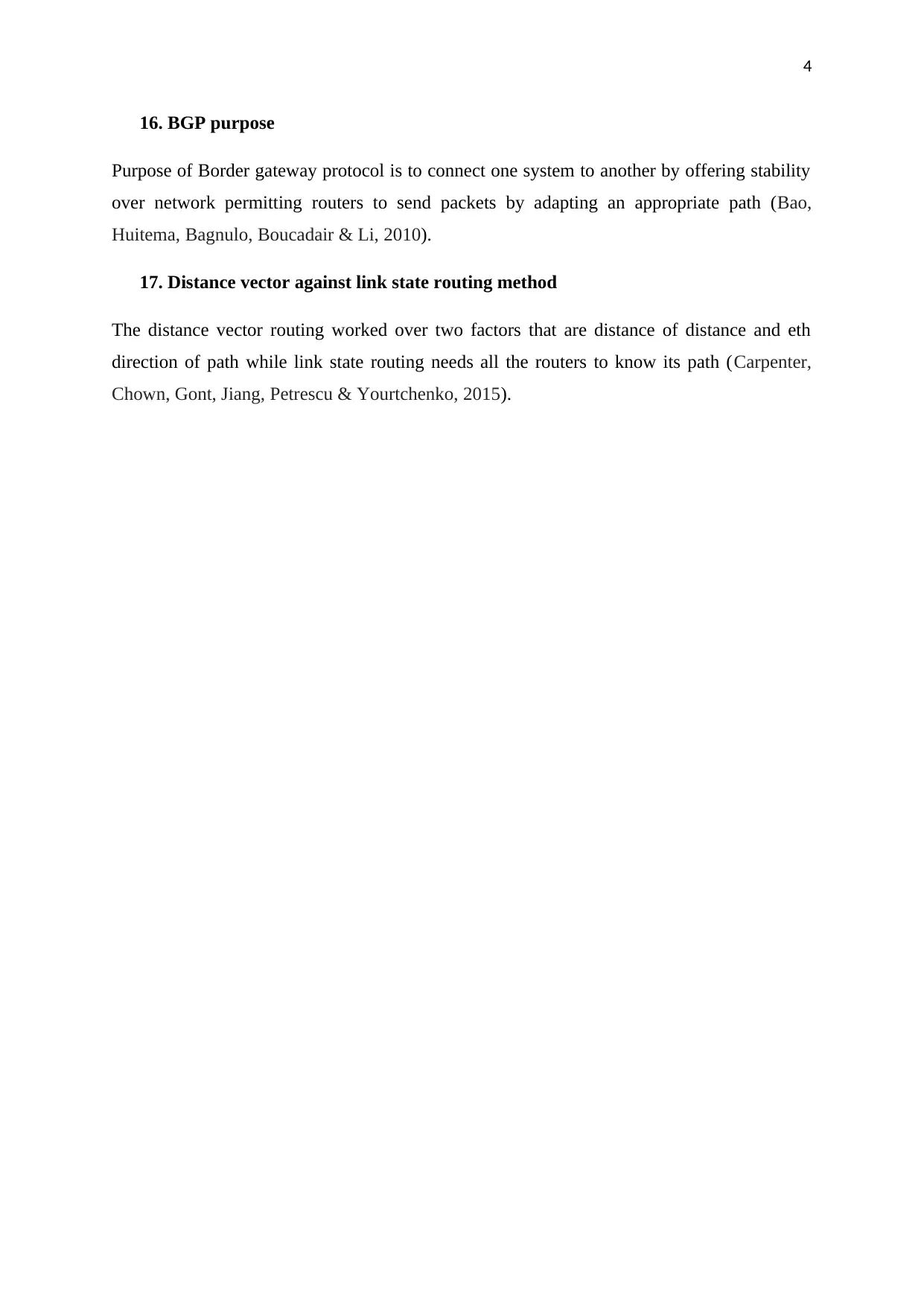
4
16. BGP purpose
Purpose of Border gateway protocol is to connect one system to another by offering stability
over network permitting routers to send packets by adapting an appropriate path (Bao,
Huitema, Bagnulo, Boucadair & Li, 2010).
17. Distance vector against link state routing method
The distance vector routing worked over two factors that are distance of distance and eth
direction of path while link state routing needs all the routers to know its path (Carpenter,
Chown, Gont, Jiang, Petrescu & Yourtchenko, 2015).
16. BGP purpose
Purpose of Border gateway protocol is to connect one system to another by offering stability
over network permitting routers to send packets by adapting an appropriate path (Bao,
Huitema, Bagnulo, Boucadair & Li, 2010).
17. Distance vector against link state routing method
The distance vector routing worked over two factors that are distance of distance and eth
direction of path while link state routing needs all the routers to know its path (Carpenter,
Chown, Gont, Jiang, Petrescu & Yourtchenko, 2015).
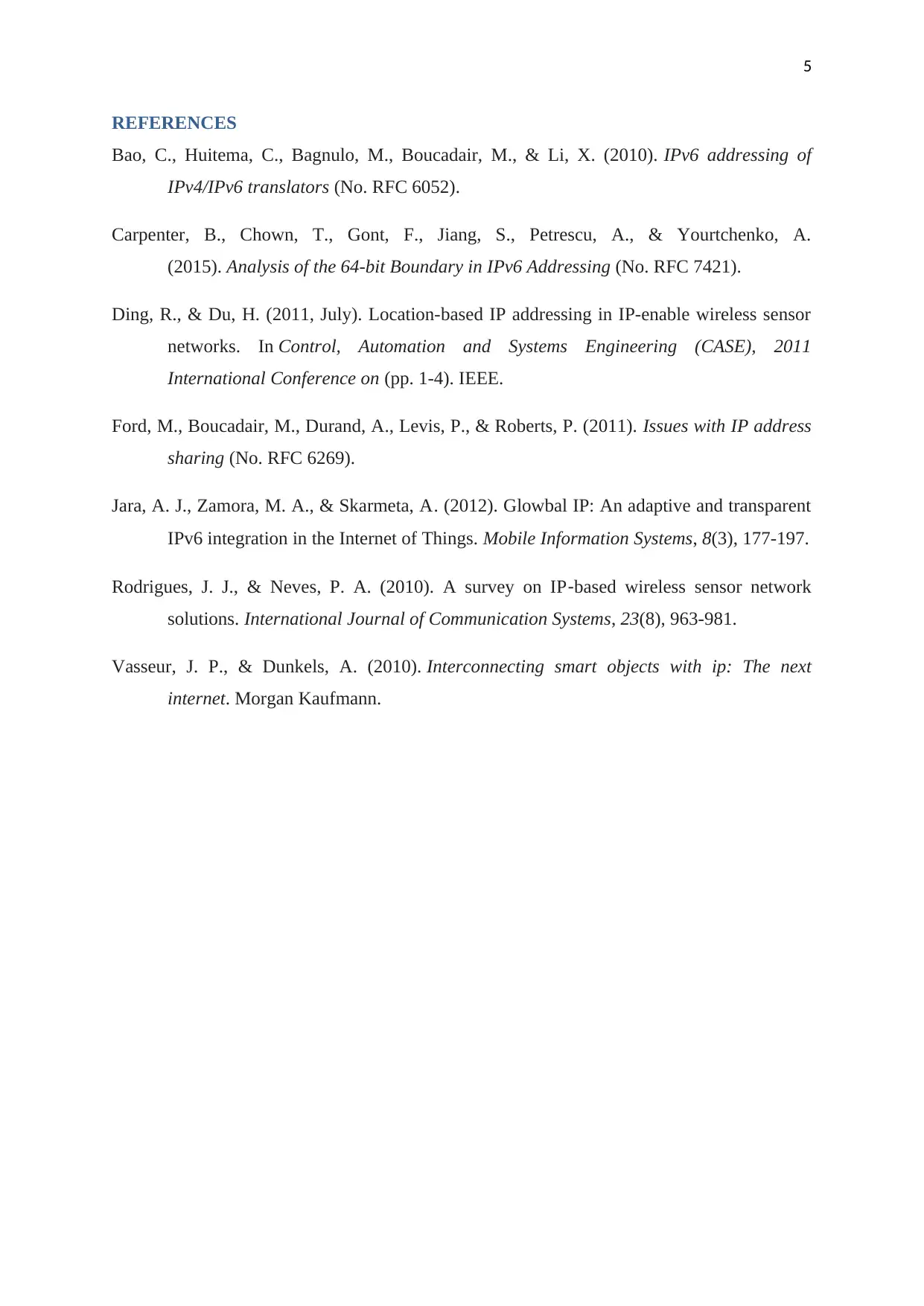
5
REFERENCES
Bao, C., Huitema, C., Bagnulo, M., Boucadair, M., & Li, X. (2010). IPv6 addressing of
IPv4/IPv6 translators (No. RFC 6052).
Carpenter, B., Chown, T., Gont, F., Jiang, S., Petrescu, A., & Yourtchenko, A.
(2015). Analysis of the 64-bit Boundary in IPv6 Addressing (No. RFC 7421).
Ding, R., & Du, H. (2011, July). Location-based IP addressing in IP-enable wireless sensor
networks. In Control, Automation and Systems Engineering (CASE), 2011
International Conference on (pp. 1-4). IEEE.
Ford, M., Boucadair, M., Durand, A., Levis, P., & Roberts, P. (2011). Issues with IP address
sharing (No. RFC 6269).
Jara, A. J., Zamora, M. A., & Skarmeta, A. (2012). Glowbal IP: An adaptive and transparent
IPv6 integration in the Internet of Things. Mobile Information Systems, 8(3), 177-197.
Rodrigues, J. J., & Neves, P. A. (2010). A survey on IP‐based wireless sensor network
solutions. International Journal of Communication Systems, 23(8), 963-981.
Vasseur, J. P., & Dunkels, A. (2010). Interconnecting smart objects with ip: The next
internet. Morgan Kaufmann.
REFERENCES
Bao, C., Huitema, C., Bagnulo, M., Boucadair, M., & Li, X. (2010). IPv6 addressing of
IPv4/IPv6 translators (No. RFC 6052).
Carpenter, B., Chown, T., Gont, F., Jiang, S., Petrescu, A., & Yourtchenko, A.
(2015). Analysis of the 64-bit Boundary in IPv6 Addressing (No. RFC 7421).
Ding, R., & Du, H. (2011, July). Location-based IP addressing in IP-enable wireless sensor
networks. In Control, Automation and Systems Engineering (CASE), 2011
International Conference on (pp. 1-4). IEEE.
Ford, M., Boucadair, M., Durand, A., Levis, P., & Roberts, P. (2011). Issues with IP address
sharing (No. RFC 6269).
Jara, A. J., Zamora, M. A., & Skarmeta, A. (2012). Glowbal IP: An adaptive and transparent
IPv6 integration in the Internet of Things. Mobile Information Systems, 8(3), 177-197.
Rodrigues, J. J., & Neves, P. A. (2010). A survey on IP‐based wireless sensor network
solutions. International Journal of Communication Systems, 23(8), 963-981.
Vasseur, J. P., & Dunkels, A. (2010). Interconnecting smart objects with ip: The next
internet. Morgan Kaufmann.
⊘ This is a preview!⊘
Do you want full access?
Subscribe today to unlock all pages.

Trusted by 1+ million students worldwide

6
1 out of 7
Related Documents
Your All-in-One AI-Powered Toolkit for Academic Success.
+13062052269
info@desklib.com
Available 24*7 on WhatsApp / Email
![[object Object]](/_next/static/media/star-bottom.7253800d.svg)
Unlock your academic potential
Copyright © 2020–2025 A2Z Services. All Rights Reserved. Developed and managed by ZUCOL.




